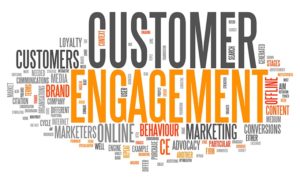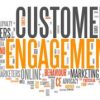Customer Engagement
Last week we discussed Customer Retention – next week, we’ll consider Customer Acquisition. This week, we’ll take a look at an aspect of the Customer Lifecycle Model rarely discussed when dealing with Small Business development: Customer Engagement.
 Before you can retain them, and even before you acquire them, you must encounter individuals and transform them from random strangers into people who would consider doing business with you. This tends to be the challenging part , and the reason why so many of us shudder and cringe when faced with the stark reality that “All Business Is Sales“.
Before you can retain them, and even before you acquire them, you must encounter individuals and transform them from random strangers into people who would consider doing business with you. This tends to be the challenging part , and the reason why so many of us shudder and cringe when faced with the stark reality that “All Business Is Sales“.
Where The Customers At?
Before we can convert a stranger into a paying customer, we have to meet them for the first time. We can either wait where we are, and hope they stumble upon us (this actually works, sort of, for “brick and mortar” retail operations), or we can go out and actively seek them. This second option is what we mean when we use the term “engagement“. Typically customer engagement refers to the channels of communication: the means by which a company communicates their brand value and brand message to prospects and clients. In this series, we expand the meaning of engagement to include:
Getting The Message Out
Meet ups. Networking events. Landing pages. Lead capture forms. Outbound email campaigns. Blog posts. Facebook posts and ads. Twitter feeds. Instagram posts. Snapchat, Pinterest, guest blogging and so on and so forth. This is what’s usually thought of as engagement: who did we meet, how many phone calls or emails did we get, how many messages did we send out, how many ads did we place, who read them, how many times were they viewed, and who click the “call to action” links. But to us, engagement is not so much about the method, but the message. The point should be to “get the word out”… the question is – what exactly IS “the word”?
 Too often our business communication consists of either straight up sales pitches, or pitches disguised as genuine conversation. If sales is a conversation about the exchange of value for money, shouldn’t we be talking about, well… value? In this context, when we talk about value we mean benefit to the customer – the desires or requirements satisfied or fulfilled by our product or service.
Too often our business communication consists of either straight up sales pitches, or pitches disguised as genuine conversation. If sales is a conversation about the exchange of value for money, shouldn’t we be talking about, well… value? In this context, when we talk about value we mean benefit to the customer – the desires or requirements satisfied or fulfilled by our product or service.
NOT a conversation about price, or features. Talk about what the customer will get out of doing business with you instead of what YOU have to give them or want to sell them. We can’t repeat this often enough: your customers DO NOT CARE ABOUT YOU. They’re not angry – they’re just not interested. You may be a nice person, respected in your field and uniquely qualified… so what? None of that has much to do with what your customer wants or needs.
Get into their world. What’s interesting to them, beyond the features and price of your product? What are they up to in their lives? Trust me: they’re not waking up thinking about your goods or services today. There’s an essential concept in marketing called your “brand message“. This is NOT the history of your brand, or how you rank compared to your competitors, nor is it a product list or your service catalog. It’s the answer to the customer’s question “What’s In It For ME?“
Consider McDonalds’ brand message: “I’m Lovin’ It“. Lovin’ what, exactly – Big Macs and shakes that contain no dairy products? No – lovin’ the experience of McDonalds itself. And while I’m completely at a loss to tell you what that experience is supposed to be, clearly their brand messaging is effective communication. McDonalds holds more market share than any other restaurant chain, including Starbucks, and crushes it’s direct competitors, owning more than half of the fast food market.
No surprise then that their commercials flood all media despite the fact that no American over the age of six months is unfamiliar with their brand. Most of that communication is NOT about advertising their product – it’s about repeating their brand value messaging. McDonalds = FUN! Think about it: their children’s food package is not called a “kid’s meal” – it’s called a “Happy Meal™”.
Keeping In Touch
 Do you keep in touch with the people that you meet or contact on the Internet? If you’re like me, you have what I call “The Stack™” – a pile of business cards, collected at various events. Most of us entrepreneurs have a “stack” – sadly, all they do is gather dust. We collect them with the best of intentions, often as the result of – wait for it – an engaging conversation. Both you and the card donor are very enthusiastic, and they either gladly surrender custody of their cardboard signifier or are the one to thrust it upon you, eagerly requesting that you contact them and keep in touch.
Do you keep in touch with the people that you meet or contact on the Internet? If you’re like me, you have what I call “The Stack™” – a pile of business cards, collected at various events. Most of us entrepreneurs have a “stack” – sadly, all they do is gather dust. We collect them with the best of intentions, often as the result of – wait for it – an engaging conversation. Both you and the card donor are very enthusiastic, and they either gladly surrender custody of their cardboard signifier or are the one to thrust it upon you, eagerly requesting that you contact them and keep in touch.
Which… you usually don’t, despite your best intentions. Want to know why? Two reasons, really:
- Within 72 hours, you will have forgotten who this person is, and why you took their card
- If you can’t immediately hustle them for a sale, you don’t really have anything much to say to them
In all honesty, most of us go to meet ups and networking events trawling for sales. The conversations tend to be like speed dating: if there’s no immediate opportunity, we’re off to the next target. Just like dating, though, customers don’t happen immediately and tend to take a bit more finesse than a blunt come-on. Only a select few people are interested in a relationship with you, and that’s true of business as well as romance.
Two suggestions we have for turning the stack into a power pack are the Sharpie™ and the brand message elevator pitch. The first is quite simple – always carry a fine point Sharpie marker with you at live events. When someone gives you their business card, IMMEDIATELY write the following on the card
- WHERE you met them
- WHEN you met them
- WHY you are taking their card
Within 72 hours, call them or send them an email. This leads to the second suggestion – the brand message elevator pitch. You’re probably familiar with the basic elevator pitch – the less-than-sixty-second summation of who you are, what you do and what your business is all about. The brand message version is just a slight variation on that concept. Where the elevator pitch is you talking about yourself and your business, the brand message variant speaks in terms of the potential customer.
Who are they? What do they value? What’s important to them, and what are they looking get out of business, work and life in general? Remember – we’re trying to dial into their “Brand Message Elevator Pitch” class=”glossaryLink”>BMEP:
You seem to be a business person who seeks to thrive and prosper in the 21st Century economy. You know that an online presence and the effective use of social media can give you a strategic advantage… but you’re still trying to figure out HOW. If this is you – let’s talk.
Simple and to the point. Notice that only once did we use a first-person pronoun, and even that was only implied (the “US” in the contraction “let’s”). Otherwise, all second-person – “YOU”. Every thing stated was aspirational. “Seeks to thrive and prosper”, not “looking to make money/be profitable”. “You know” what the solution is (“online presence”, “social media”) AND what the solution can provide (“strategic advantage”). Observe that we don’t end in a pitch, but an invitation: YOU are the one seeking a solution, we’re just requesting a conversation.
Nowhere in this Do It Yourself” class=”glossaryLink”>DIY, YouTube and Google fix-it type? There’s no point even going on about our bona fides if all they’re looking for is to chat with a peer and compare notes.
This is why the brand message elevator pitch is useful. It gives us a first conversation to have without being “sales pitch-y” at all, and it helps US filter out the window shoppers and tire kickers from the true potential customers. Now, we’re prepared to have that first conversation in a timely manner, because we know what to say and how to say in — dare I say it — an engaging manner. Of course, this is just the first step. Hopefully we will winnow away the browsers from the buyers, and it will be time to take the next step. THAT step is Acquisition. And that’s next week’s post. Stay tuned…







